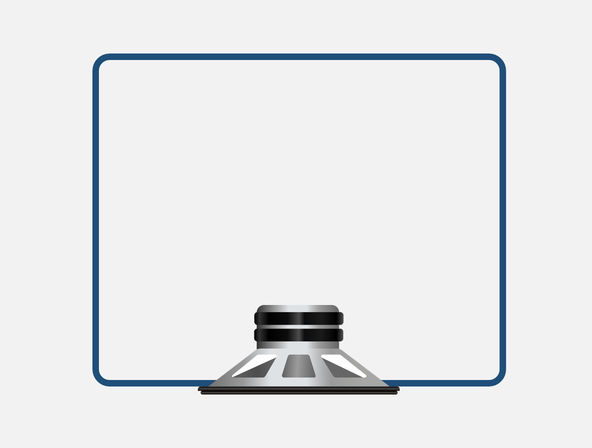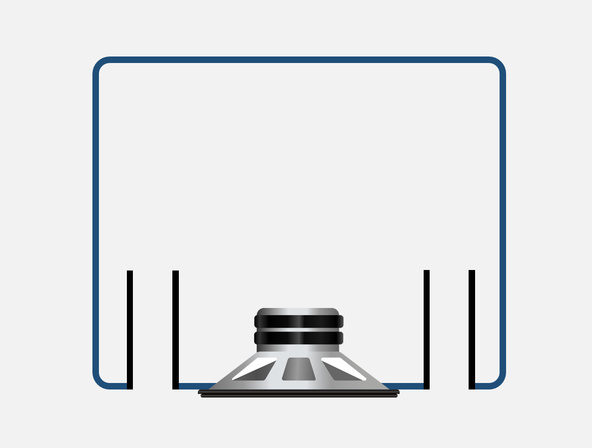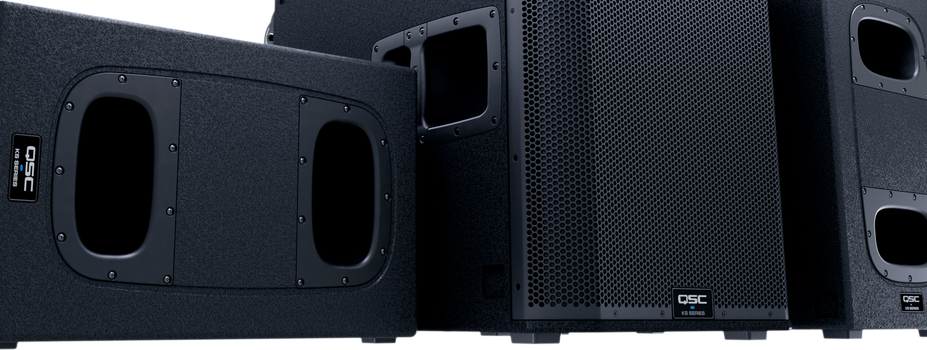The history of the subwoofer is inextricably linked with the evolution of the full-range loudspeaker. In the mid-1950s, various manufacturers of hi-fi loudspeakers began to introduce compact, closed-box enclosures that featured long-throw woofers, and in the early 1970s a talented engineer working at Jensen, named James Novak, developed the equations describing a bass reflex (or vented) loudspeaker design.
The ability to reproduce extended low frequencies was of particular interest to the movie industry, and in the mid-1970s Cinerama (then Cinema-scope) and Todd-AO Studios first brought multichannel sound to large cinema screens together with a center mono channel that had the role of providing ‘bass extension’. The first movie to feature this ‘bass extension’ channel was Star Wars in 1977.
In addition to subwoofers becoming an essential addition to standard stereophonic reproduction systems during the late-1970s, today, with the wide acceptance of multichannel audio and the proliferation of music genres encompassing extreme low-frequency content, subwoofers play an essential role in any type of sound reproduction system, from live music PA systems to DJ setups, and more.
Enclosure and Sound Wave Interference
Before discussing specific enclosure designs, it is important to recall that the main purpose of a loudspeaker enclosure is to prevent the front and rear-firing waves from canceling one another. The best way to examine this phenomenon is to remember that sound waves have peaks, consisting of high air pressure, and troughs, consisting of low air pressure. The air changes from high to low pressure at a speed determined by the pitch of the sound. The position of this waveform at any given time is referred to as its ‘phase’.
A driver/cone pushing air from both its front and back will create sound waves that are 180 degrees out of phase (peaks and troughs are in opposite alignment). This effect becomes problematic if the two different sound waves meet, as the interference between them will result in sound cancellation. Conversely, if the peaks and troughs are in alignment (in-phase), the sound summation will result in an increase in sound pressure (and hence loudness).
Acoustical Challenges
The most essential property for a subwoofer is its ability to move (or resonate) air, and this is determined by its maximum driver excursion and effective piston area. To achieve a constant sound pressure level as frequency decreases, the air volume that must be displaced is proportional to 1/(frequency)2. In other words, the air volume displacement increases by 12 dB per octave with decreasing frequency. This relationship is independent of enclosure design.
As an example, if we need 50 cm3 of volume displacement at 100 Hz to achieve 110 dB SPL, we need 1250 cm3 at 20 Hz to produce the same SPL. Additionally each doubling of the SPL (+6 dB) requires twice the volume displacement. With this in mind, it quickly becomes apparent that the physical and mechanical constraints on low-frequency drivers are significant, and present a major challenge when attempting to achieve high sound pressure level in addition to low-frequency extension.
For the remainder of this article, we will focus on subwoofer enclosure types rather than low-frequency driver designs and challenges. Most subwoofer enclosure designs are either “closed” (or sealed), “vented” (or reflex/ported) or “band-pass”. For each of these designs, the subwoofer efficiency is proportional to the internal volume of the enclosure. Smaller boxes provide lower efficiency, necessitating greater amplifier power to produce a given SPL output. In other words, a small enclosure combined with a 1000 W amplifier could achieve, theoretically, the same SPL as a larger box with a 100 W amplifier. However, the resulting trade-off is elevated acoustic distortion since the same driver in a smaller enclosure would need to be pushed harder to achieve the same SPL.
Closed-box (sealed) Enclosure
A closed-box (or acoustic suspension, or sealed) enclosure is an airtight chamber that is typically compact and easy to build due to the lack of port (or vent). Such a design prevents sound waves emitted from the back of the driver from interfering with (or cancelling) those from the front. A closed-box subwoofer consists of an amplifier, an enclosure, and a driver that is responsible for all of the system’s acoustic radiation.

As the driver moves back and forth, the air pressure in the enclosure constantly changes, causing additional pressure to build up at the rear of the cone (or diaphragm). In order to overcome this phenomenon, extra amplifier power is required for the driver inside of a closed-box subwoofer to produce the same SPL as it would in a comparable vented box. However, this phenomenon also has its advantages, as the extra pressure allows the cone to move back and forth very quickly and precisely.
Such designs usually exhibit a very flat frequency response, typically causing the reproduced bass to be perceived as “tight”. They also feature a 12 dB/octave low-frequency roll-off, the least steep of all of the designs discussed in this article. They also exhibit less phase rotation (an intentional distortion to the waveform to attempt to make asymmetric signals more symmetrical) and reduced ringing in the time domain, allowing them to reproduce sharp transient sounds with high fidelity.
Basic pros and cons of closed-box enclosures:
- Pros: Simple, space-saving design; tight bass and excellent transient response; good power handling; no potential for noise/distortion due to port chuffing.
- Cons: Requires greater amplification to overcome the internal air pressure on the rear of the diaphragm; limited bass response below the system’s resonant frequency.
Vented (reflex/ported) Enclosure
A vented (or bass reflex/ported) enclosure features one or more port(s), which allow the pressure between the inside and outside of the enclosure to be equalized. When the driver diaphragm moves backwards into the enclosure, the internal pressure increases and is subsequently released through the enclosure port, causing port resonance at a particular frequency. The port augments the system output at this frequency by providing additional surface area and air displacement, resulting in an extension of low-frequency response and increased SPL.

The port tuning frequency is a function of its cross-sectional area and length. Vented designs produce more sound pressure level near the tuning frequency than closed-box enclosures of equivalent volume, although they actually have less output at frequencies well below the cut-off frequency, since the LF roll-off is steeper (24 dB/octave for a vented enclosure versus 12 dB/octave for a closed-box).
It must be noted that a vented enclosure design should generally be used in conjunction with a subsonic electrical filter (LF high-pass filter) to restrict frequencies below the cut-off frequency. Because there is no acoustic suspension for the woofer below the tuning frequency of the enclosure, if the woofer reproduces signals below this tuning frequency, damage could occur to the woofer suspension because of excessive cone travel (or “unloading”).
Vented enclosures can also dramatically decrease amplifier power requirements since they increase efficiency by around 3 dB when compared to closed-box enclosures. In order to match an acoustic increase of 3 dB output through amplification, the power applied to the subwoofer would need to be doubled. One example of a vented subwoofer enclosure design is the QSC KS118, which is a direct-radiating, 18-inch, active subwoofer that is capable of achieving 136 dB peak SPL at 1 meter with 3600 watts (peak) of Class D amplification.
Basic pros and cons of vented enclosures:
- Pros: High SPL; deep and strong bass reproduction; high acoustic efficiency requiring less amplifier power for a given SPL (compared to a closed-box design).
- Cons: the bass reproduced may be less precise (possibly described as ‘boomy’) in non-optimized designs; vents/ports can produce chuffing noise if not properly designed (due to insufficient cross-sectional area, exits not adequately flared, etc.); larger enclosure size required to accommodate ports.
Band-Pass Enclosure
This special type of subwoofer enclosure has two separate chambers instead of one. The primary chamber, which can be either a closed-box or a vented-type design, contains the subwoofer driver, while the secondary chamber creates the so-called ‘band-pass’ effect on the subwoofer’s response.
In general, band-pass subwoofers are highly efficient and reproduce deep low frequencies within a limited bandwidth. While a great deal of care is required in the fine-tuning of such designs, the resulting acoustic level increase can be up to 8 dB. The rapidly changing airflow in both chambers provide the advantage of low woofer excursion and well-controlled cone motion. However, the resulting pressure build-up necessitates the selection of a mechanically durable driver with a quality suspension and strong cone to ensure long-term reliability. From a handling perspective, these designs are impervious to direct driver damage from outside impact, thanks to the driver(s) being confined within the enclosure. The use of multiple chambers and port(s) also often result in relatively large, bulky enclosures that can be challenging for transportation and storage.
Single-Vented Band-Pass Design
A single-vented band-pass design features a driver mounted in a closed-box chamber, firing into a vented chamber, which simulates a 4th-order electrical band-pass filter. In this case, the waves emanating from the rear of the driver cone are trapped within the closed-box, and the radiation from the front surface of the cone is directed into the vented chamber, modifying the driver resonance. The closed-box chamber exhibits, as expected, a 12 dB/octave low-frequency roll-off, and the vented, secondary chamber produces a 12 dB/octave high-frequency roll-off. The name “band-pass” comes from the combined band-limiting effect of these two acoustic roll-offs.

Dual-Vented Band-Pass Design
A dual-vented band-pass design differs from the single-vented by the fact that the first chamber containing the driver is also vented, yielding a 6th-order band-pass response. Such designs are difficult to properly tune and tend to be very sensitive to specific driver characteristics. They feature the same benefits and drawbacks as the vented design, including an expected 24 dB/octave low-frequency roll-off, but with even greater efficiency thanks to the band-pass configuration.
Both the QSC KS112 KS212C are active subwoofers employing dual-vented band-pass enclosure designs (6th-order band-pass response). The single 12-inch KS112 achieves 128 dB peak SPL at 1 meter with 2000 watts (peak) of Class D amplification. The KS212C is a fully cardioid model achieving 132 dB peak SPL at 1 meter with a total of 3600 watts (peak) of Class D amplification. It features dual 12-inch drivers each in a separate, dual-vented band-pass enclosure. The fully cardioid KS212C subwoofer also provides 15 dB of front-to-rear attenuation.

Basic pros and cons of band-pass enclosures:
- Pros: Acoustically efficient design with deep bass reproduction; limited woofer excursion and low distortion; highly durable; choice of closed-box and vented designs for the first chamber.
- Cons: High resistance to cone movement; complex enclosure design requiring advanced knowledge for proper tuning; enclosure could be fairly large.
Conclusion
Closed-box, vented and band-pass enclosures all have inherent advantages and disadvantages that make them ideal for different applications. For example, closed-box subwoofers, while providing “tight” sounding bass that may be desirable for low-level listening applications such as home audio or home theatre, may lack the efficiency desired by a DJ or for large-scale PA systems that can only be provided by vented or band-pass designs.
Furthermore, all of the common designs described above are found not only in subwoofer products, but also in the low-frequency portion of “full-range” loudspeakers. Specific applications necessitate different trade-offs between acoustic performance, such as maximum SPL and sound quality, and practical features such as size and durability. No one subwoofer does it all, but we hope your next subwoofer purchasing decision will be better informed. Happy bass listening!

Great article!